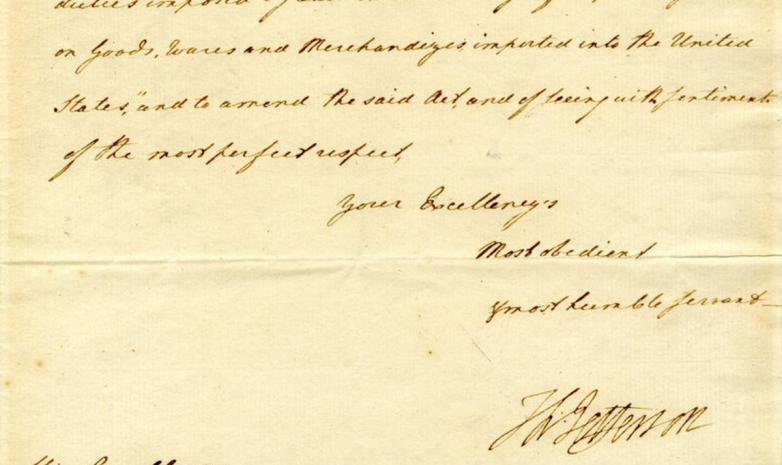University Archives to Hold 415-Lot Autographs & Books Auction

Secretary of State Thomas Jefferson’s signed letter, dated April 19, 1790, addressed to Samuel Huntington, Governor of Connecticut, regarding the suspension of part of the 1789 Revenue Act. Estimate: $15,000-$20,000
Wilton, CT – A large historic pen sketch hand-drawn and signed by Apollo XI astronaut Neil Armstrong, a manuscript fragment in George Washington’s hand from the first draft of his first Inaugural Address in 1789, and the Black-Scholes-Merton formula handwritten and signed by Nobel Prize-winning economist Robert C. Merton are just a few of the expected superstar lots in University Archives’ online-only auction slated for Wednesday, September 28th, at 10:30 am Eastern time.
The Rare Autographs, Manuscripts & Books auction features historical material from multiple collecting categories. All 415 lots are up for viewing and bidding now (on the University Archives website: www.UniversityArchives.com), plus LiveAuctioneers.com, Invaluable.com and Auctionzip.com. Phone and absentee bids will be taken, but there’s no live gallery bidding.
“Our September auction offers collectors, dealers, and institutions the opportunity to acquire outstanding autographed material, relics, photographs and more,” said John Reznikoff, president and owner of University Archives. “Sale highlights in the Science & Space, U.S. Presidents, and Military History collecting categories will draw significant interest. Premier items can also be found in the Music, Early American, International, and World Leaders collecting categories.”
The large, 21 inch by 15 inch historic pen sketch hand-drawn and signed around 1990 by Neil Armstrong depicts important elements of the Apollo XI moon landing, including the trajectories of the command and lunar modules, plus the dark side of the moon represented by hatch marks. The drawing has been authenticated by Steve Zarelli Space Authentication (est. $90,000-$110,000).
The double-sided manuscript fragment comprising over 60 words in George Washington’s hand, from the draft of his First Inaugural Address, was authenticated by 19th century Washington biographer Jared Sparks. The exquisite content relates to the Constitution. The fragment should finish at $60,000-$70,000.
Robert C. Merton (b. 1944) was the co-developer of the Black-Scholes-Merton formula, which revolutionized modern financial trading and earned him the shared 1997 Nobel Prize in Economics. He penned the famous formula and signed his name on stationery from Stockholm’s Grand Hotel, while in Sweden to accept his Nobel Prize (est. $45,000-$55,000).
Sir Isaac Newton’s 300-plus-word autograph manuscript draft of a religious treatise, believed to have been created around 1698, questions the concept of the Holy Trinity and reprises a 4th century debate concerning whether God, Christ, and the Holy Ghost were separate substances. Newton asks if “God or any part of him was born of the Virgin…” (est. $28,000-$35,000).
Secretary of State Thomas Jefferson signed an April 19, 1790 letter addressed to Samuel Huntington, the Governor of Connecticut, announcing the suspension of a controversial clause of Alexander Hamilton’s 1789 Revenue Act, which threatened the autonomy (and the profits) of Virginia merchants by imposing duties on Potomac River-bound vessels (est. $15,000-$20,000).
Speaking of Hamilton, a rare letter both written and signed by Hamilton circa 1791 to the cashier of the Bank of New York, has an estimate of $15,000-$18,000. The note regards an assumption plan for the famous “Sinking Fund” of Revolutionary War states’ debts.
The handwritten lyrics to the song America the Beautiful (often referred to as Our Nation’s Second National Anthem), boldly signed by the song’s author, Katharine Lee Bates, all four stanzas on one 8 ½ inch by 5 ½ inch sheet, no date given, is estimated to hit $15,000-$17,000. Bates wrote the first draft of America the Beautiful in 1893, while teaching English in Colorado.
An extensive archive of more than 40 documents ranging from 1786-1851, documenting the earliest days of the U.S. Navy and including the signatures of Matthew C. Perry, William Bainbridge, David Porter, and other naval commanders and various Navy Department officials, is a ready-made collection of naval notables and should find a new owner for $10,000-$12,000.
A nice companion lot to the naval documents would be a letter written and signed by Franklin D. Roosevelt, as president, dated Feb. 19, 1934, in which he writes, “I, too, have been collecting source material for many years – mostly U.S. Navy” (est. $7,000-$8,000). The letter is addressed to Frank C. Deering, a bibliophile considered one of the great collectors of early Americana.
The clipped signature of Thomas Lynch, Jr. (1749-1779), the second youngest of the Declaration of Independence signers (and the second rarest), taken from a larger letter or document, has a pre-sale estimate of $10,000-$12,000. Lynch replaced his father, who had fallen ill, as a South Carolina delegate to the Stamp Act Congress and the Continental Congress, 1774-1776.
A bound volume of General Orders issued from the Adjutant General’s Office of the War Department from Jan.-Nov. 1865, including printed military orders related to the demobilization of the Union Army, the situation of freedmen and other military matters, like General Orders No. 66 issued April 16, 1865 announcing Abraham Lincoln’s assassination, should make $10,000-$12,000.
Four pieces, dated between 1873-1889, either signed by or including important content related to George A. Custer, Major Marcus Reno and other Battle of Little Bighorn veterans, carries an estimate of $8,000-$9,000. The documents and letters can be tied to the disastrous battle itself and its the immediate aftermath, including the recovery of relics and subsequent courts-martial.















